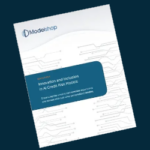By W.B. King

For this year’s annual Finopotamus “Holiday Tech Wish List,” we sat down with forward-looking fintech and credit union executives who shared their tech hopes and forecasted market realities for 2024. Due to a significant number of intriguing responses, this year’s Wish List will be presented in five installments.
Part Five includes insights from American Credit Union, Core10, Pulsate, Modelshop, Union Credit, Jack Henry and TruStage.
Wishing for a Security-Conscious Workplace
America’s Credit Union’s Chief Information Officer Troy Kyle wishes for a work environment “where our teams are not just tech-savvy, but also deeply security-conscious.” If his wish is granted, he said it would result in a workforce where each employee is “so well-informed and transparent in their approach that the very notion of shadow IT fades away into oblivion.”
In jest, he offered: “Well, one can dream.” On a more serious note, he added: “A workplace where wisdom and vigilance in cybersecurity are as natural to us as our morning coffee.”
While he believes the $704 million Tacoma, Wash.-based credit union, which serves more than 36,351 members at 13 branches and supports 160 employees, is on the right track, he said there are certain obstacles.
“Sometimes we can be our own biggest stumbling block, getting swept away by flashy buzzwords and the latest tech fads that are really just old tricks in new bottles. The real challenge lies in the ever-changing world of apps – they’re so easy to enable or activate, but often without enough oversight or guidance,” he continued. “It’s a bit like opening Pandora’s Box, especially with these low and no code apps where anyone can just ‘sign-up’ and kick things into motion.”

To stay one step ahead, he said it is imperative that the credit union focuses on security, understanding data governance and mastering change management.
“Embracing change and staying flexible is not just good practice; it’s essential,” he noted. “We need to keep reinforcing these ideas, almost like a mantra, to stay ahead in this dynamic landscape.”
As he looks toward 2024, his hope is that the credit union industry excels in the “digital realm” and maintains its “relevance and connection” to long-standing members while attracting the next generation who have near limitless options when it comes to banking.
“SoFi, a fintech giant, refers to their customers as ‘members,’ much like we do in the credit union industry. This is actually quite significant — SoFi is creating a sense of community and belonging, something that has always been our unique selling point in credit unions,” he said.
“This blurs the lines between traditional banks and credit unions, potentially making it harder for us to stand out,” he continued. “It’s a subtle move, but it’s like they’re speaking our language, which could make it more challenging for us to differentiate ourselves and highlight what makes credit unions truly special.”
Wishing Credit Unions Embrace New Technologies in Commercial and Omnichannel Banking
While Core10’s Vice President of Revenue and Marketing Tyler Brantley celebrated the credit union’s stellar track record in retail banking, he wishes credit unions would better capitalize on commercial lending products in the coming year.
“Changes in regulations in recent years have enabled credit unions to explore more commercial opportunities and see a positive shift in their position within the commercial market,” he told Finopotamus, adding that his wish also call for a renewed approach to omnichannel banking.
“Omnichannel experiences enable members to engage seamlessly with their credit union across various touchpoints, deepening their relationship and streamlining all interactions – whether through their banking app, at the branch, or in conversations with customer service representatives,” he offered. “Members have come to expect a fast and seamless experience, and omnichannel platforms enable credit union to offer exceptional service while meeting members wherever they are.”

The Franklin, Tenn.-based fintech provides turnkey solutions to community banks and credit unions, making it easier to implement cutting-edge technologies, including application programming interface (API) integration, software as a service (SaaS) implementation and lending products.
“To enhance their commercial banking capabilities, CUs must undergo internal transformation by focusing on improving staff skill sets, knowledge, and tech resources,” he said. “Many CUs have been unable to gain the upper hand in the commercial arena because they lack the in-house resources necessary to accomplish this growth.”
Turning his attention to his second wish, omnichannel experience, he said credit unions “interested in taking the next step toward delivering a seamless digital experience need a strong integration strategy and the necessary tools in place to achieve their goals.”
As 2024 approaches, Brantley hopes that the credit union industry continues to build strategic partnerships with fintechs that serve the evolving needs of members.
“By collaborating with fintech partners, credit unions can offer fintech-powered capabilities to bolster impactful engagement with their members, without the need for additional bandwidth or resources for in-house development,” he noted. “Cultivating and strengthening these strategic relationships can empower credit unions to embark on essential digital transformation initiatives and evolve their internal capacities for more streamlined growth in the approaching year.”
Wishing to Deepen Digital Relationships
Noting that 90% of American consumers prefer digital channels when banking and that one in five consumers check banking apps at least once per day, Pulsate CEO Sarah Martin’s 2024 wish is that credit unions leverage technology solutions that create personalized and meaningful interactions.
“By aligning tech strategies with the evolving needs and expectations of members, credit unions can deepen and nurture those digitally-driven relationships for long-term, sustained success,” she told Finopotamus.
The Dublin, Ireland-based fintech, which has a U.S. presence, offers a mobile-first multichannel proactive growth platform built specifically for community banks and credit unions.

While the financial services industry often focuses on short-term goals, such as the trend to acquire deposits at any cost, Martin said many financial institutions (FIs) “struggle to prioritize tools and technologies” that can deepen digital relationships with members.
“The institutions that instead choose to prioritize a strategic focus on long-term objectives, like building better and stronger relationships, position themselves to be top of mind when their members have financial needs while increasing opportunity for growth and success,” she said.
In the coming year, Martin hopes the credit union industry embraces a “strategic shift” that places consumers at the center of all tech-related decisions.
“The industry has experienced some significant changes and challenges over the past year, which prompted a shift from the focus on lending to a heightened emphasis on deposits.
While this move is necessary for the institutions, it’s critical that the needs and experiences of the member be addressed and prioritized,” she continued. “Focusing on these needs, preferences and overall satisfaction will allow credit unions to create a more member-centric banking experience, fostering higher trust and loyalty to help the industry grow and thrive.”
Wishing to Reduce Unintentional Socioeconomic Bias Credit Decision Models
Modelshop CEO Tom Tobin’s wish for 2024 is that “risk teams embrace new data and new analytic tools to build higher-performing models while reducing unintentional socioeconomic bias in their credit decisions.”
The Newark, N.J.-based fintech provides a no-code platform and suite of lending models designed to accelerate automation of credit risk, origination and servicing decisions.
“Traditional credit scorecard and segmentation models haven’t changed a lot in 20 years, but the makeup of credit union member bases have evolved dramatically,” Tobin told
Finopotamus. “Risk teams are justifiably sensitive to making changes to their credit decision models, but my hope is that 2024 is the year credit union risk build new tools that use more data to help level the economic playing field for their diverse member communities.”

Over the past year, Tobin explained that he has had many forward-looking conversations with credit union leaders on advanced decision-making strategies.
“I believe that 2024 will be the year that credit union first-movers will not only demonstrate better performance from their next-generation decision models, but will show more balanced outcomes for their historically underserved members,” he continued. “Throughout my 30-year career in the credit analytics space, I’ve considered credit unions a bright spot because of their unrelenting focus on doing what is right for their members.”
Over the course of his career in the credit analytics space, credit unions, he said, are “a bright spot” because of their “unrelenting focus on doing what is right for their members.” He also noted recent media coverage regarding unfair and unfortunate credit practices that are antithetical to credit model strategies purported to be unbiased.
“Emerging data, tools and techniques we have available to us today can do a significantly better job than traditional models and decision tools,” he offered. “My hope is that credit unions, with their focus on fairness and member value, will help lead the charge to smarter, more transparent and fairer credit strategies in 2024.”
Wishing for Technologies that Drive Member Acquisition and Long-Term Growth
Union Credit’s Co-Founder and Chief Revenue Officer Barry Kirby’s 2024 wish for credit unions: “Invest in the appropriate technology for new member acquisition, which will invigorate the credit union’s business and drive long-term growth and success.”
Noting shifting consumer preferences, aging membership and the “ongoing threat from large banks and fintechs acquiring credit unions’ members,” he told Finopotamus: “It’s time for credit unions to shed their reactive mindset and start to proactively engage with younger consumers who are embarking on their financial journey and have not yet committed to an institution.”

The San Jose, Calif.-based fintech provides consumers with one-click credit offers embedded within their daily activities.
“Relying solely on traditional methods such as mail campaigns, Facebook ads and SEO is no longer sufficient,” he said. “Embedded finance provides a reliable, efficient, and cost-effective solution, allowing credit unions to connect with consumers through faster, smoother, and more personalized experiences precisely when younger consumers need them and through their preferred channels.”
For his wish to be realized, Kirby said credit unions must “break free from traditional marketing methods” and embrace new strategies.
“My hope for the credit union industry in 2024 is that it sheds the label of being the best-kept secret in banking,” he continued. “With a diverse range of competitively priced products and services, credit unions are well-positioned to address consumers’ unique financial situations by responsibly providing relevant product options that align with their needs and contribute to their financial wellness.”
Wishing to Solve the Financial Health Crisis
Citing the Financial Health Network’s Trends Report, Shanon McLachlan, president of credit union solutions at Jack Henry, noted that the number of financially vulnerable Americans grew to 17% in 2023, up from 15% in 2022.
As such, his wish for 2024 is for credit unions to help solve the financial health crisis. “This may entail investing in modern, open technology that allows them to easily embed the latest, most suitable fintech solutions for their organization,” he told Finopotamus.
“The rise of new players, like non-traditional financial service providers and challenger banks, play a role as they have created an unprecedented level of fragmentation in the industry,” he continued. “Credit unions can address this by adopting open banking to offer members a comprehensive view of their finances and control over their data – open technology infrastructure enables consumers to connect their financial apps, while still giving them the control to manage their data (e.g., be able to permission data on their own terms).”
To support his stance, he noted that as of October of 2023, the Consumer Financial Protection Bureau made it a requirement to enable customer financial data sharing without the use of screen scraping. Additionally, he added that the closure of Mint by Intuit, which now redirects users to Credit Karma, “presents a sense of urgency for credit unions as Credit Karma is now competing directly against financial institutions.”
He continued. “Open banking provides an opportunity for credit unions to level the playing field, embedding do-it-for-me, impact-oriented tools, instead of traditional budgeting options, making it easier for members to monitor and take control of their finances within digital banking experience.”

The Monett, Mo.-based firm provides technology solutions designed to enable FIs to innovate faster, strategically differentiate, and successfully compete, while serving the evolving needs of their accountholders.
Asked the likelihood of his wish coming true, McLachlan told Finopotamus he is confident Jack Henry can make it a reality.
“The challenge lies in credit unions being open to these changes and investing in the right resources. Partnering with a forward-thinking technology partner can help to guide them through this transformation,” he offered. “We’re already working with many credit unions on their fintech strategy, and we’ve made great progress in getting rid of screen scraping for over 700 financial institutions.”
As he looks forward, he hopes credit unions continue “fostering robust and meaningful connections” with members and the communities in which they work and live.
“In the new era, your credit union can – and should – act as a safe and secure platform that matches your members with the most relevant fintech innovations in meaningful timeframes,” he said. “With the right fintechs and open banking rails, credit unions can simplify financial complexities for members. This positions them well to serve the communities that depend on them for financial well-being.”
Wishing to Harness the Full Potential of Digital Channels and Data
As TruStage’s Senior Vice President of Client Success Baron Conway sees it, credit unions have only “scratched the surface” on the amount of member data aggregated. As such, his 2024 wish is for “credit unions to harness the full potential of their digital channels and the wealth of data available to them.”
Credit unions, he added, have “so many opportunities” to access data in a “user-centric manner” that is relevant, meaningful and that can help their members live better lives.
“I envision a continued shift towards a user-centric approach, where credit unions use data in meaningful ways to understand their members’ needs and preferences,” he told Finopotamus. “The goal is to offer products and services that genuinely benefit members’ lives, rather than simply focusing on profit-driven sales.”

The Madison, Wis.-based fintech provides insurance, investment and technology services to the credit union industry, including its Digital Storefront platform.
As far as his 2024 wish coming true, Conway said credit unions are “increasingly recognizing the importance of prioritizing the digital experience” for their members.
“Technologies such as artificial intelligence (AI) can be instrumental in analyzing data to help personalize digital storefronts inside digital banking where members can scroll through to select the most relevant offers that match their needs – similar to Amazon,” he continued.
“The challenges are less about the state of the economy or availability of technology, but more about the will, understanding and vision of the credit union industry to see this opportunity and run with it. If they do, and I believe they can, then 2024 will be the beginning of a great run for the industry.”







